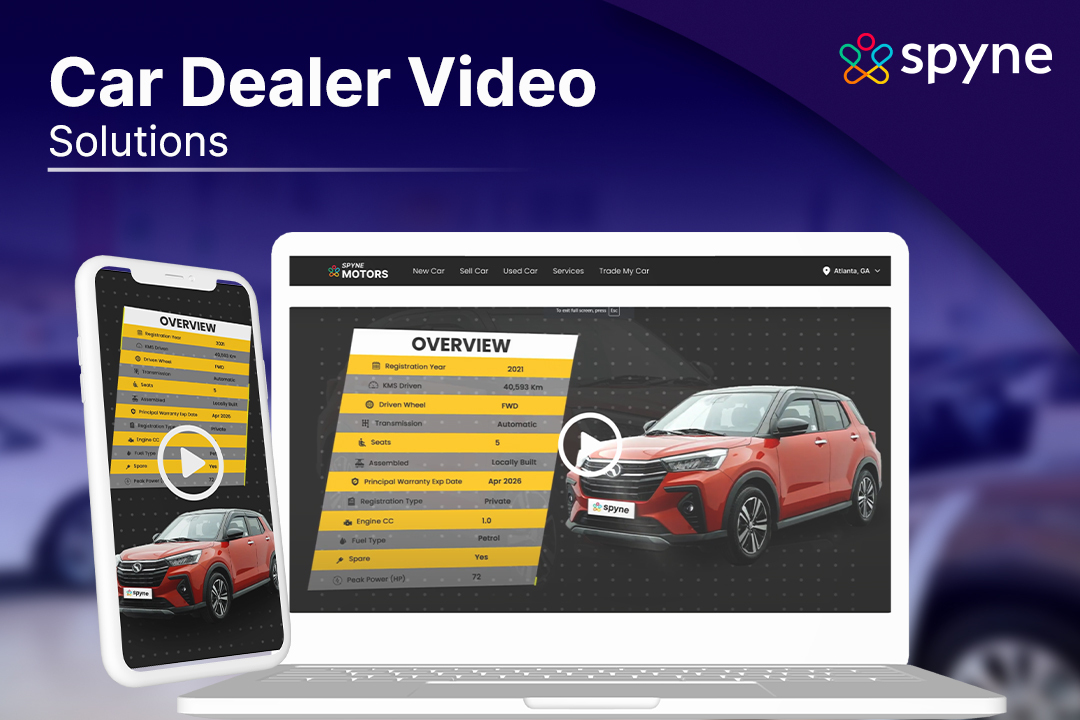The automotive market is fiercely competitive, and with the rise of digital-first consumers, dealerships are increasingly relying on innovative video solutions to differentiate their brands, build trust, and convert leads. Video has become essential for engaging customers, educating them on vehicle features, showcasing inventory, and delivering memorable experiences—both online and in-person.
Let’s dive into the specifics of how car dealer video solutions can transform automotive dealerships, enhancing customer engagement, improving conversion rates, and boosting overall sales.
Why Video Matters in Automotive Dealerships
Video marketing has gained traction across industries, but it holds particular significance in the automotive sector due to its ability to create an immersive experience. With 80% of consumers reporting that videos give them more confidence in purchase decisions, it’s no wonder that video solutions are becoming central to dealership marketing strategies.
For automotive dealerships, video serves multiple purposes:
- Showcase Inventory: Video allows dealerships to present cars in a dynamic way, highlighting details that still images can’t capture.
- Build Trust: Seeing the faces of dealership employees fosters a connection that builds trust with potential customers.
- Enhance SEO: Websites with embedded videos rank higher on search engines, increasing visibility for dealership sites.
- Provide Convenience: Prospective buyers can watch videos of vehicles from their homes, saving time and providing the convenience that today’s consumers expect.
Types of Video Solutions for Automotive Dealerships
A variety of video solutions can be tailored to meet the unique needs of automotive dealerships. Here’s a closer look at the primary types of videos that dealerships can leverage.
1. Inventory Walkaround Videos
An inventory walkaround video provides customers with an up-close look at each vehicle’s unique features, making it feel like a virtual tour. Dealers can either use a full 360-degree walkaround video or highlight specific areas like the interior, exterior, or engine.
Benefits
Detailed Showcase: Customers get a real sense of the car’s condition, look, and feel.
Time-Saving: Walkaround videos allow buyers to view cars remotely, making the sales process faster and more efficient.
Enhanced Engagement: Viewers are more likely to watch a complete video compared to skimming through photos.
2. Test Drive Videos
Test drive videos capture the feel of driving a specific car model, giving potential buyers an idea of the car’s performance, handling, and features. These videos can include first-person footage, showing both interior controls and the road ahead.
Benefits
Improves Conversion Rates: Customers feel more informed and confident, making them more likely to buy.
Interactive Experience: A test drive video offers an interactive experience that builds excitement and trust.
Increases Online Presence: Test drive videos perform well on platforms like YouTube, increasing a dealership’s online reach.
3. Customer Testimonial Videos
Positive customer testimonials are powerful because they serve as social proof, showcasing genuine buyer satisfaction. When satisfied customers share their experiences in a video, it resonates with potential buyers.
Benefits
Builds Trust and Credibility: Prospective customers tend to trust fellow buyers’ opinions.
Influences Decision-Making: Seeing a happy customer encourages others to visit and make a purchase.
Increased Engagement on Social Media: Testimonial videos are popular on social media, extending the dealership’s reach and visibility.
4. Educational and Informational Videos
These videos provide valuable information about car maintenance, financing options, or understanding specific features of different car models. Educational videos help dealerships position themselves as experts and build trust with customers.
Benefits
Positions Dealership as a Thought Leader: By offering useful insights, the dealership builds credibility.
Builds a Loyal Customer Base: Customers appreciate dealerships that educate them, leading to repeat visits.
Increased Organic Traffic: Educational videos are often shared and revisited, enhancing organic traffic.
5. Personalized Video Messages
Using personalized video messaging, sales representatives can connect with leads directly, addressing specific inquiries or questions. Whether responding to a lead’s question or following up after a visit, personalized videos make interactions more memorable.
Benefits
Enhanced Customer Experience: Personalized videos make customers feel valued and recognized.
Higher Engagement Rates: People respond better to personalized content, increasing open rates for emails.
Strengthens Relationships: Personalized interactions help create long-term relationships with customers.
How to Implement Video Solutions in Automotive Dealerships
To make the most of video solutions, automotive marketing dealerships need a strategic approach that ensures content reaches and resonates with the target audience. Below are the key steps to consider for successful video marketing implementation.
Step 1: Define Your Goals and Audience
Before creating any video content, dealerships must define their goals and target audience. Are they trying to increase brand awareness, generate leads, or drive foot traffic to the showroom? Each goal will require a slightly different video approach.
Step 2: Invest in the Right Equipment
Professional-looking videos require the right equipment. Dealerships don’t necessarily need high-end gear, but they should have basic equipment, including:
High-Quality Camera: For clear, crisp visuals that accurately represent the vehicles.
Microphone: Good audio quality is essential for clear communication.
Lighting: Proper lighting will enhance the vehicle’s appearance and create a polished look.
Step 3: Choose the Right Video Platform
Dealerships need to post videos on platforms where their audience spends time. YouTube, Facebook, and Instagram are the most popular options, but the dealership’s website should also serve as a hub for video content.
Step 4: Optimize for SEO
Video content should be optimized with relevant keywords, tags, and descriptions. Optimizing for SEO ensures that videos appear in search engine results, attracting more organic traffic to the dealership’s website.
Step 5: Monitor Performance and Adjust
Dealerships need to monitor video performance to understand what works and what doesn’t. Metrics like view count, engagement rate, and conversion rate will reveal insights into customer preferences, guiding adjustments to improve future videos.
Best Practices for Automotive Video Content Creation
Creating effective automotive video content requires a blend of creativity, technical skill, and customer focus. Here are some best practices to ensure video content resonates with potential buyers:
- Keep Videos Short and Engaging: For platforms like social media, shorter videos work best. Aim to keep most videos under two minutes to retain viewer attention.
- Highlight Key Features: Focus on features that are unique or highly appealing for specific models.
- Incorporate Calls to Action (CTA): Direct viewers to take action, whether that’s visiting the website, contacting a salesperson, or scheduling a test drive.
- Showcase Dealership Culture: Incorporate the team’s personality, showing the dealership’s commitment to customer service.
- Use Multiple Angles: Capture both the exterior and interior of the vehicles, giving viewers a comprehensive view.
Leveraging Live Video for Enhanced Engagement
Live video is another powerful tool that dealerships can use to increase engagement. Live videos allow potential customers to join in real-time, ask questions, and get instant responses from dealership staff.
Benefits of Live Video
Real-Time Interaction: Potential customers can get immediate answers to their questions, making them feel more connected.
Increased Visibility: Platforms like Facebook and Instagram give priority to live videos, helping dealerships reach a larger audience.
Cost-Effective: Live video requires minimal post-production, making it a budget-friendly option.
Enhancing Customer Experience with Virtual Reality (VR) and Augmented Reality (AR)
As technology advances, some dealerships are adopting VR and AR to offer customers an immersive car-buying experience. These technologies allow customers to “see” and “test drive” vehicles virtually.
Benefits of VR and AR
Increases Engagement: VR and AR allow customers to explore vehicles in an interactive way.
Appeals to Tech-Savvy Buyers: These technologies attract younger customers who appreciate innovation.
Reduces Physical Visits: With virtual tours, customers can explore options online, making them more likely to visit in person with serious buying intent.
Challenges in Implementing Video Solutions
While the benefits of video solutions are clear, there are challenges dealerships may encounter:
- Budget Constraints: High-quality video production can be costly, particularly if specialized equipment or professional editing is involved.
- Time and Resource Management: Creating and maintaining video content requires time and a dedicated team, which may be challenging for smaller dealerships.
- Content Saturation: As more dealerships adopt video, standing out becomes more difficult. Unique angles and creativity are essential.
- Measurement and ROI: Tracking the return on investment from video content can be complex, particularly if the dealership lacks tracking tools.
Future Trends in Video Marketing for Automotive Dealerships
The landscape of video marketing is continually evolving, and dealerships should stay informed about emerging trends to remain competitive. Key trends to watch include:
AI-Powered Video Personalization: AI can personalize videos for each customer, improving engagement.
Shoppable Video Content: Interactive videos that allow viewers to click and explore vehicle details or make inquiries.
360-Degree Video: Full immersion for virtual vehicle tours, enhancing the customer experience.
Conclusion
Video solutions for automotive dealerships are not just a trend—they’re a necessary part of modern dealership marketing. From inventory walkarounds and test drives to personalized messages and live broadcasts, video content allows dealerships to connect with customers in meaningful and memorable ways. By embracing video solutions, dealerships can boost engagement, enhance the customer journey, and drive more sales.
Automotive dealerships that adopt and strategically leverage video solutions will likely




